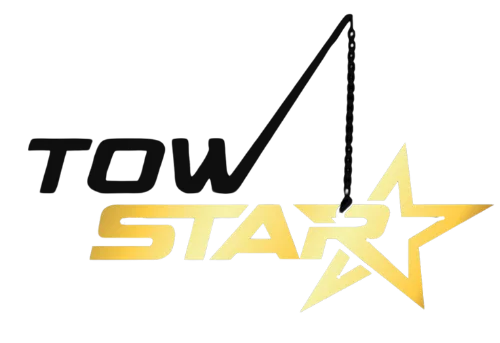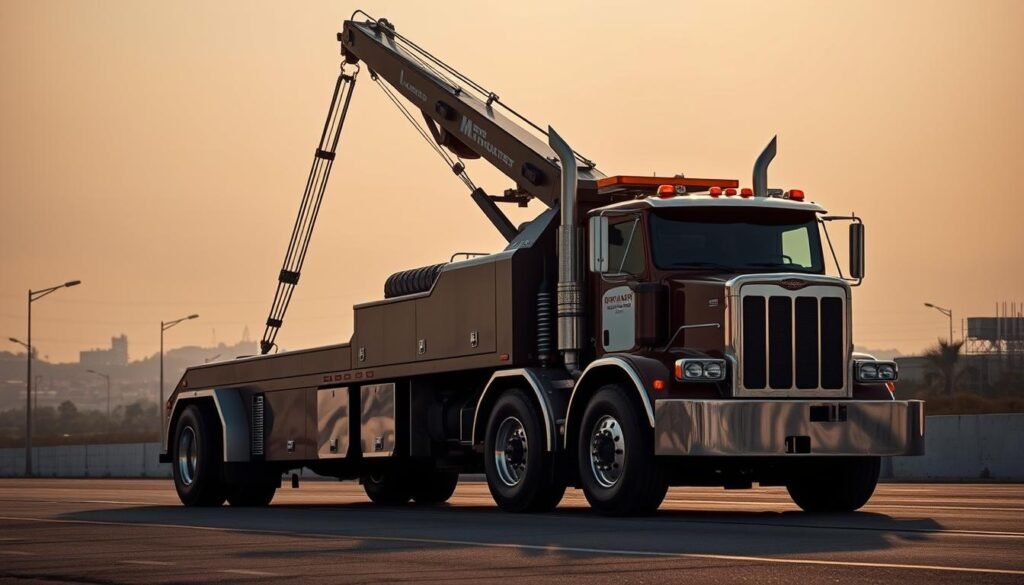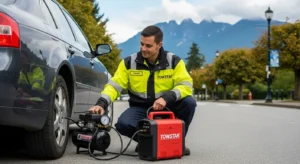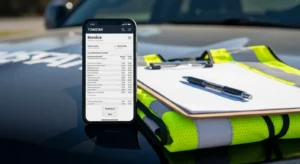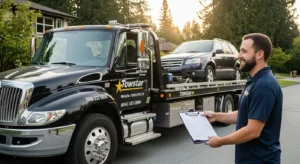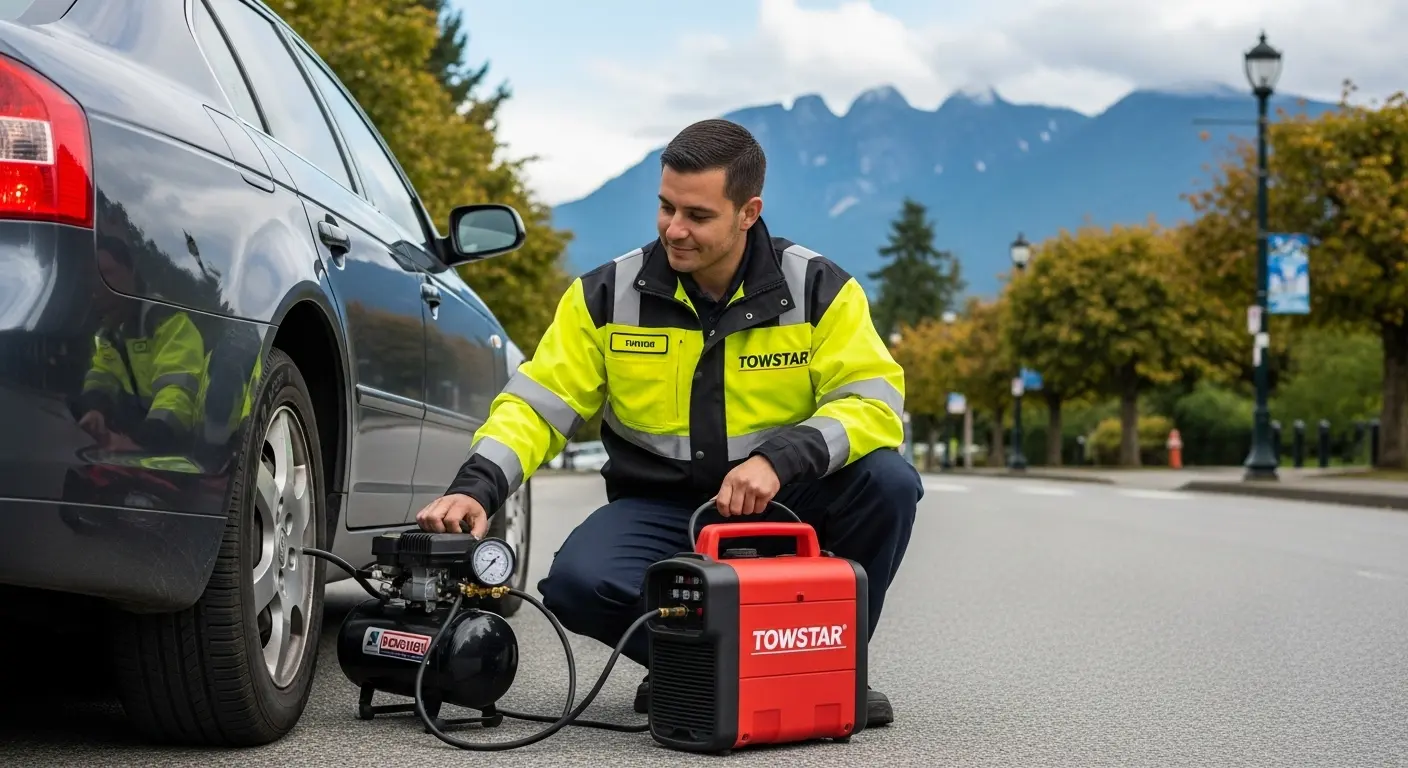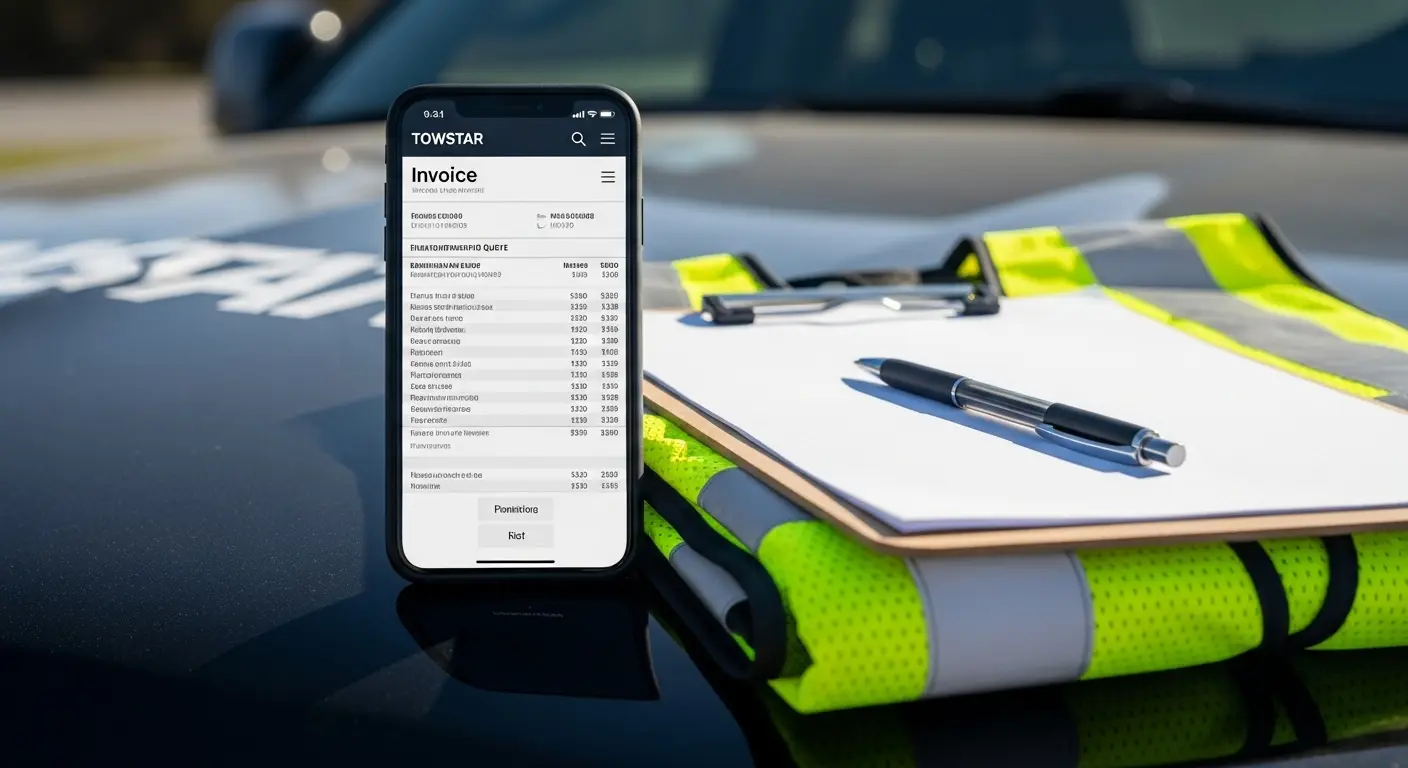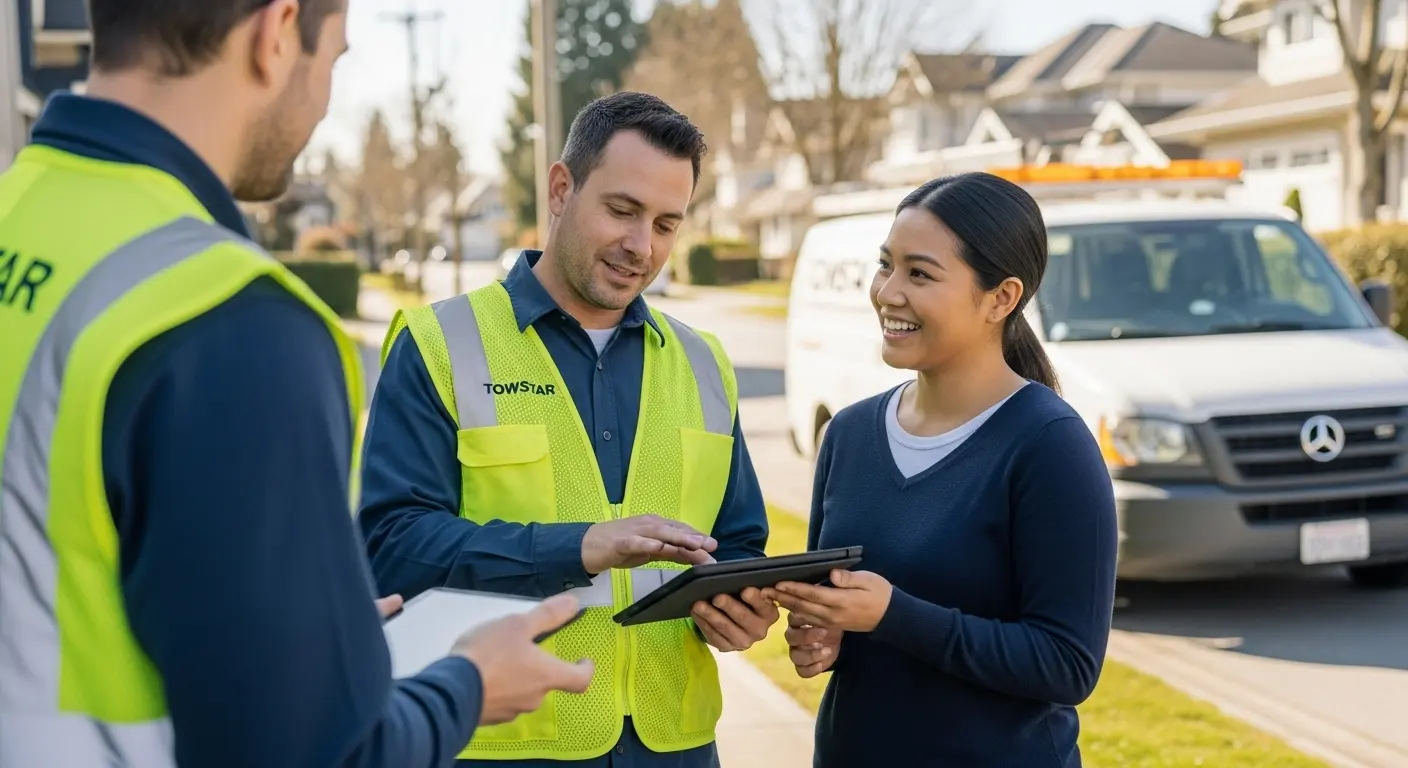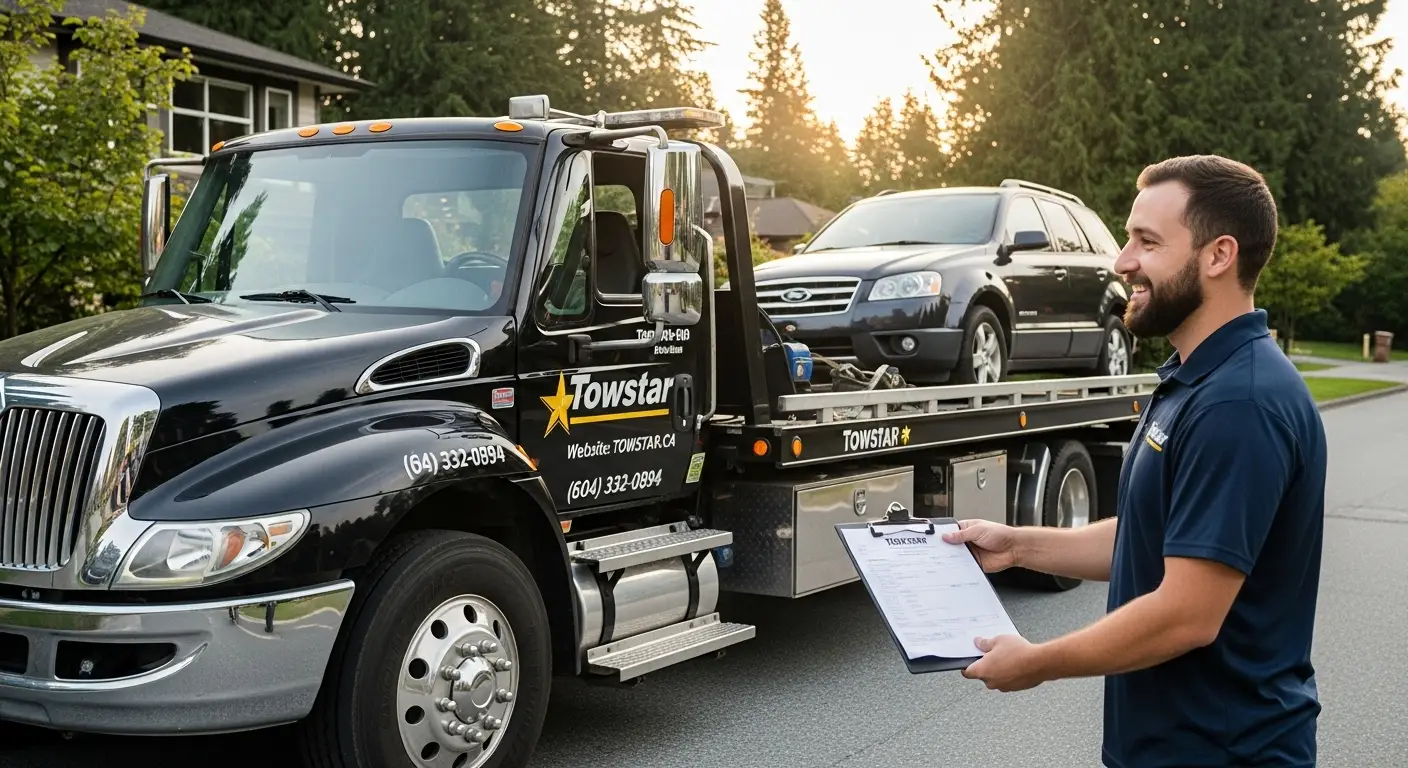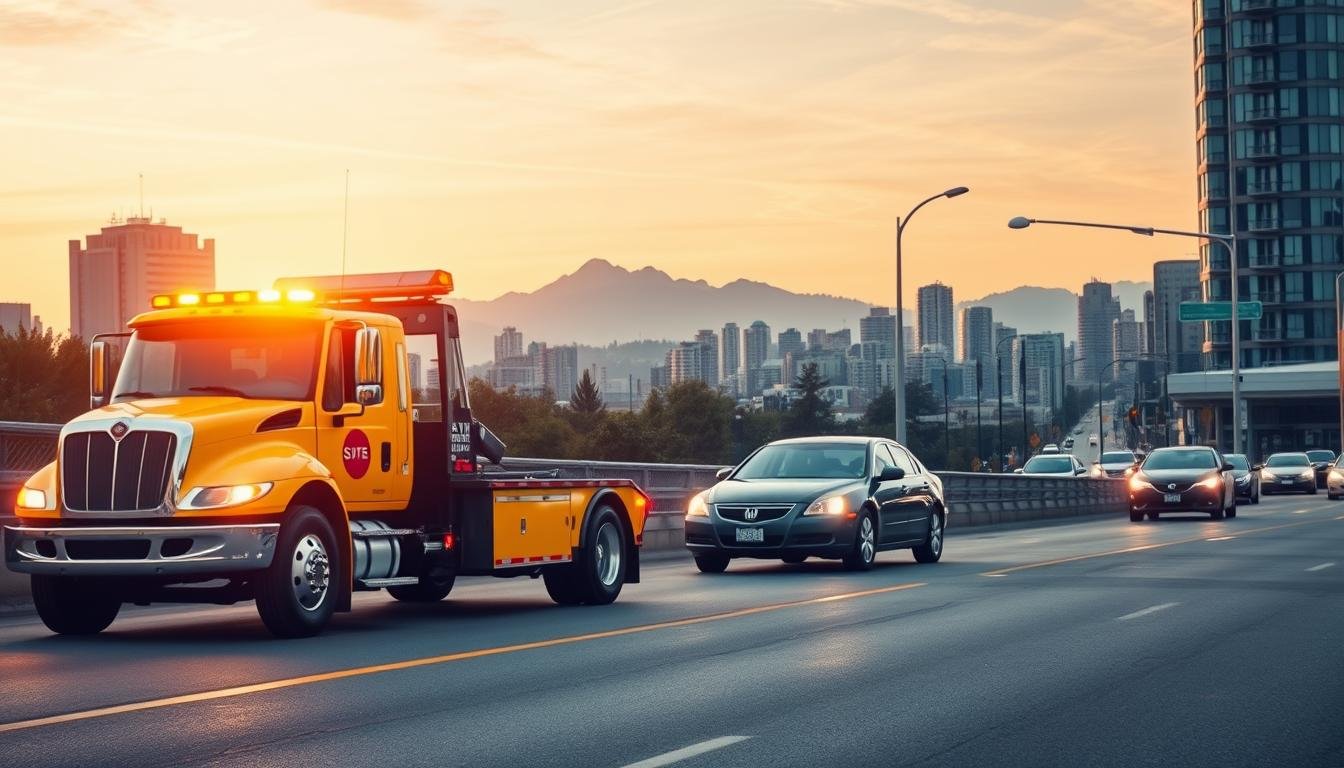Imagine being stuck on a snowy Trans-Canada Highway with a broken-down transport vehicle. You need help now, not a crash course in towing. That’s what this guide is for!
This guide is the latest resource for Canadian drivers and fleet managers. It helps you deal with vehicle recovery situations. Whether it’s a commercial truck or an RV emergency, knowing your options helps you regain control.
Our 2025 edition does more than just explain terms. You’ll learn about:
- New safety tech in recovery vehicles
- How climate changes affect towing practices
- Your rights during roadside assistance
This guide isn’t just about understanding winches. It’s about making quick, smart choices. Let’s turn “vehicle crisis” into “problem solved” together!
Key Things to Remember
- Modern recovery vehicles now feature AI-assisted load balancing
- Always verify service provider certifications before emergencies occur
- Winter tires aren’t just for cars – tow operators need them too
- Provincial regulations differ for commercial vs personal vehicle recovery
- Emergency kits should include high-vis gear for nighttime incidents
What is a Heavy Duty Tow Truck?
Standard tow trucks can’t handle vehicles over 17,000 lbs. Heavy duty tow trucks are the strong heroes of roadside help. They are made for Canada’s toughest recovery jobs.
Definition and Purpose
These trucks are for vehicles over 17,000 lbs. Think semi-trucks on icy Alberta roads or construction gear stuck in Ontario mud. Unlike your cousin’s pickup, heavy duty trucks have strong frames and parts.
They can do many things, like:
| Vehicle Type | Max Tow Capacity | Typical Recovery Scenarios |
|---|---|---|
| Ford F-150 | 13,500 lbs | Light commercial vehicles |
| RAM 3500 | 37,090 lbs | Medium-duty trucks |
| Heavy Duty Tow Truck | 80,000+ lbs | Semi-trailers, buses, industrial equipment |
Common Use Cases
These trucks are used all over Canada for many things. You might see them:
- Helping with highway tractor-trailer rollovers
- Getting construction equipment out of trouble
- Rescuing transit buses in winter storms
- Getting oversized RVs out of campgrounds
- Moving farm machinery in the prairies
They can handle any job, from a logging truck in BC to a snowplow in Montreal. Heavy duty towing experts have the right tools and know-how to get your stuff back safely.
Types of Heavy Duty Tow Trucks
Ever wondered why some tow trucks look like they’re hugging a car while others hoist it like a forklift? Choosing the right heavy-duty tow truck isn’t just about power—it’s about matching the equipment to your specific recovery needs. Let’s break down the three main types so you’ll know exactly what works for your situation.
Hook and Chain Tow Trucks
Don’t let the old-school name fool you—modern hook systems are gentler than ever. These trucks use reinforced straps (not chains!) to secure vehicles by their frames. Perfect for heavy industrial jobs like moving construction equipment or recovering large trucks stuck in mud. The Chevy Silverado HD, for example, handles up to 36,000 lbs with its fifth-wheel setup.
Best for:
- Farm machinery recovery
- Transporting bulldozers
- Winch-out services in rugged terrain
Wheel-Lift Tow Trucks
Need a quick city tow? Wheel-lifts are your go-to. They cradle just the front or rear wheels using a metal yoke, keeping the rest of the vehicle elevated. You’ll see these often clearing accident scenes on highways—fast, efficient, and less likely to scrape low-clearance vehicles.
Why drivers love them:
- Works in tight parking garages
- No need for special attachments
- Handles most standard-sized trucks
Flatbed Tow Trucks
When you need to protect luxury cars or delicate machinery, flatbed towing is king. The entire vehicle rests on a hydraulic platform, completely off the ground. No dragging, no bouncing—just smooth transport. Ideal for high-value recoveries or vehicles with all-wheel drive systems that can’t be towed on wheels.
Flatbed advantages:
- Zero wear on tires or drivetrains
- Fits oversized loads
- Safer for icy Canadian roads
Key Features of Heavy Duty Tow Trucks
When your rig gets stuck on the Trans-Canada Highway, you need more than just strength. You need smart engineering. Modern heavy-duty tow trucks have the power and precision tech for safe breakdown recovery and heavy hauling. Let’s look at what’s important under the hood and in the cab.
Engine Power That Doesn’t Quit
Today’s heavy-duty trucks have diesel engines with over 1,000 lb-ft of torque. This is enough to pull a fully loaded semi uphill. Look for:
- Turbocharged cooling systems to prevent overheating during long hauls
- Hybrid options like Ford’s PowerBoost with 570 lb-ft torque + electric assist
- Transmissions tuned for stop-and-go recovery work
Towing Tech That Thinks Ahead
It’s not just about lifting – it’s about controlling the load. Advanced systems now include:
- Auto-adjusting wheel lifts that compensate for uneven weight distribution
- RAM’s trailer sway damping built directly into the chassis
- Remote-operated underlift systems for safer accident scene recoveries
Safety You Can Feel
These trucks protect both operators and stranded drivers through:
- 360° camera systems with night vision capabilities
- Stability control that adjusts brake pressure 100x/second
- Smart load sensors that warn before exceeding capacity limits
Pro Tip: Always check for integrated emergency lighting controls. They’re key for safe roadside operations during Canadian winters!
Heavy Duty Tow Truck Specifications
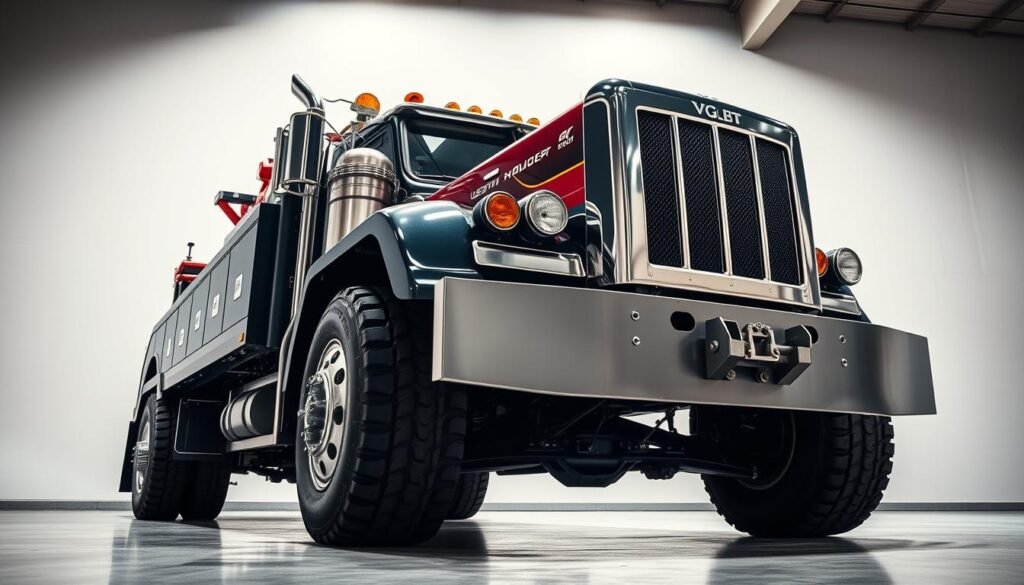
When picking a heavy duty tow truck, specs are more than just numbers. They guide you to safety and efficiency. Let’s look at the top three specs to help you choose wisely.
Weight Ratings: Your Safety Guardrails
The Gross Vehicle Weight Rating (GVWR) shows how much weight your truck can carry safely. Going over this can lead to equipment failure or fines. For instance:
- Ford Super Duty models can handle up to 40,000 lbs – great for big commercial vehicles
- Canadian models often have 10-15% higher ratings because of stronger frames
Remember to check both axle ratings and total GVWR. Your province will appreciate it!
Dimensions: Size Matters in Tight Spaces
The size of a heavy duty tow truck impacts its ability to move and store. Standard Canadian wreckers usually have:
- 8-9 meters long (about 1.5 school buses!)
- 4-meter wheelbase for stable weight distribution
- RAM 3500’s 96.5″ width – narrow enough for most urban lanes
Pro tip: Check your garage doors before buying. That extra inch could save you thousands in modifications.
Materials Built for Canadian Winters
Our tough weather calls for strong materials. Look for these in your heavy duty tow truck:
- High-strength steel alloys in frames (common in Ontario-made models)
- Aluminum alloy wheels that resist salt corrosion
- Polyurethane-coated hydraulic lines that won’t crack at -40°C
These materials aren’t just durable. They help your truck work well in all weather.
Buying Considerations for Heavy Duty Tow Trucks
Choosing the right heavy duty tow truck is more than just looking at horsepower. It’s about finding the perfect match for your business and budget. Let’s explore three key factors to help you make a confident choice.
Budget and Financing Options
Buying a truck is a big investment in your business. The Ford Maverick’s $4,000 tow package shows how extra features can affect costs. Here are some things to consider:
- Compare interest rates from Canadian lenders
- Calculate fuel/maintenance costs over 5 years
- Ask about provincial rebates for commercial vehicles
Remember, a $10,000 price difference means you’d need 500+ extra service calls to break even. The terms of your financing are just as important as the price itself!
New vs. Used Trucks
| Factor | New Trucks | Used (3-5 yrs) |
|---|---|---|
| Upfront Cost | Higher | 30-50% savings |
| Warranty | Full coverage | CPO programs only |
| Downtime Risk | Low | Higher |
Used trucks can be great deals, but always get a mechanic’s check. Check for rust from Canadian winters and make sure the frame welds are solid!
Manufacturer Reputation
A good brand is like snow tires – you’ll appreciate it when conditions get tough. Look for:
- 24/7 Canadian parts availability
- Local service centres in your province
- Proven performance in -40°C weather
Pro tip: Ask other tow operators at truck stops – real-world experiences beat brochures every time!
Top Brands in the Heavy Duty Tow Truck Market
Choosing the right brand for heavy hauling is like picking a winter tire. You want something reliable for Canadian conditions. These three manufacturers lead the market with their unique strengths:
Freightliner: The Muscle Behind Heavy Hauling
Freightliner’s rigs are perfect for moving 36,000lbs or more. They handle Canada’s toughest terrains with ease. Their trucks come with:
- Cold-weather optimized diesel engines
- Extra-wide wheelbases for load stability
- Factory-installed block heaters standard
Pro tip: 82% of Canadian repair shops stock Freightliner parts. This is important when you’re stuck in Thunder Bay during a snowstorm.
International: Urban Tow Truck Masters
International’s shorter-frame models are great for navigating tight city streets. They offer:
- 360-degree camera systems
- Collision avoidance technology
- Best-in-class turning radius
Their 15-year corrosion warranty shows they know about Ontario’s salt-heavy roads.
Kenworth: The Long-Haul Champion
Kenworth’s sleepers and fuel-efficient designs are perfect for long-hauls. They help drivers:
- Reduce cabin fatigue on Trans-Canada Highway routes
- Cut diesel costs by up to 18%
- Access roadside assistance within 90 minutes nationwide
Fun fact: 9/10 Kenworths sold in Canada are over 20 years old!
Maintenance Tips for Heavy Duty Tow Trucks
Keeping your heavy-duty tow truck in top shape is key. It’s not just about avoiding breakdowns. It’s about being ready to help others with roadside assistance. A well-maintained truck means fewer surprises and more reliable service, even in Canadian winters. Here are three essential routines to keep your truck running smoothly.
Regular Inspections
Inspections are as important as your morning coffee. Daily checks save time and avoid bigger problems later. Here’s a quick checklist:
- Fluid levels (oil, coolant, brake fluid)
- Tire pressure and visible damage
- Light functionality (headlights, brake lights)
Weekly deep dives are also important. Use a flashlight to inspect:
| Area | What to Check | Red Flags |
|---|---|---|
| Chassis | Rust spots, loose bolts | Flaking metal, missing fasteners |
| Hydraulics | Hose integrity, fluid leaks | Drips under the truck, swollen lines |
| Electrical | Battery terminals, wiring | Corrosion, exposed copper |
Oil Changes
Your engine needs oil, but not as often as you might think. Modern synthetic oils can last 15,000-25,000 km between changes. Always check your manual. Ford’s hybrid models can go up to 12,000 km between changes!
| Oil Type | Max Distance | Best For |
|---|---|---|
| Conventional | 5,000-8,000 km | Older models |
| Synthetic Blend | 10,000-12,000 km | Mixed fleets |
| Full Synthetic | 15,000-25,000 km | Newer trucks |
Tire Care
Canadian roads need tough tires. Check tire pressure weekly. Underinflated tires wear out 25% faster. Rotate tires every 10,000 km and align wheels twice a year. Remember, winter means using cold-weather hydraulic fluid and snow-rated tires.
Pro tip: Carry a tire depth gauge. If treads are below 4/32″, you might need roadside assistance yourself. Better safe than spinning wheels in a ditch!
Heavy Duty Tow Truck Insurance Requirements
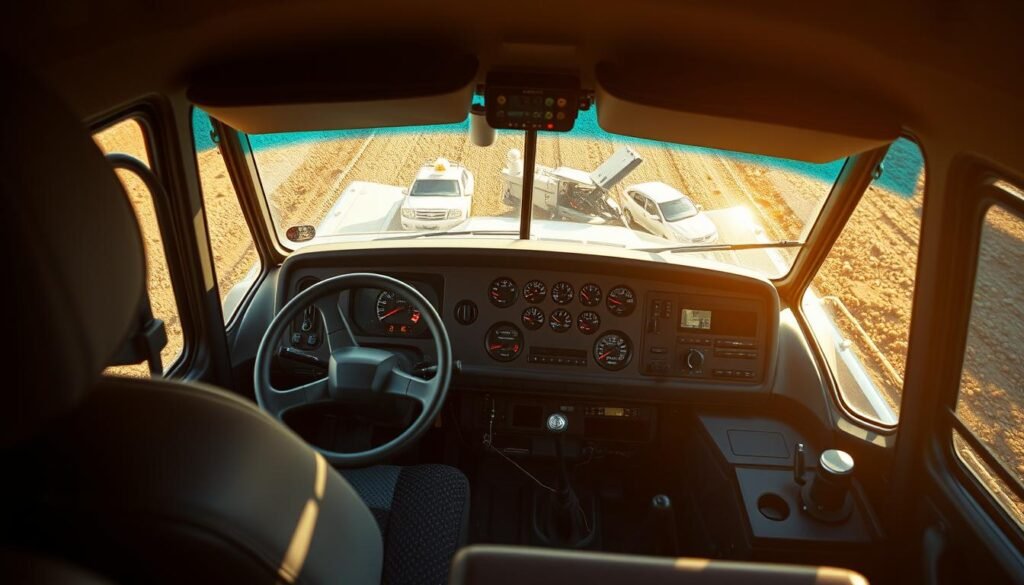
You’re driving a 12-ton truck in a blizzard when a deer jumps out. Without the right insurance, this could be very costly. We’ll look at how to keep your truck and wallet safe with the right coverage.
Types of Coverage That Matter
Canadian winters are unpredictable, and so should your insurance. Here are the essential protections:
- Liability Coverage: You need at least $2 million, but some places require more for big loads.
- On-Hook Protection: This is key for hauling expensive vehicles like the Rivian R1T.
- Cargo Insurance: It’s extra protection for valuable goods you’re moving.
- 24/7 Roadside Assistance: For those late-night calls in bad weather.
Picking Your Insurance Partner
Not all insurance companies get what heavy-duty towing needs. Here’s what to look for:
| Feature | Why It Matters |
|---|---|
| Provincial Compliance | It meets local rules from BC to Newfoundland. |
| Claims Response Time | They should handle emergencies in under 2 hours. |
| Equipment Coverage | It covers winches, dollies, and special gear. |
| Weather Clauses | They should have clear coverage for icy or snowy situations. |
When talking to insurance companies, ask about their experience with heavy-duty towing claims. A good test is to describe hauling a jackknifed semi in Northern Ontario’s cottage country. If they don’t seem worried, they might be the right choice for you.
Regulatory Compliance for Heavy Duty Tow Trucks
Keeping your heavy-duty tow truck compliant is more than just avoiding fines. It’s about keeping everyone safe on the road. Whether you’re hauling construction equipment or handling heavy-duty towing jobs in BC, knowing Canadian regulations is key.
Licensing and Certifications
You’ll need specific credentials based on where you operate. Here’s a quick breakdown:
- Ontario: Class D license for vehicles over 11,000kg
- British Columbia: Annual safety certification for commercial carriers
- Alberta: Q-endorsement for trucks exceeding 11,794kg
- Quebec: Mandatory brake inspection every 12 months
Provincial Regulations
Rules change quickly, like a flatbed hooking up to a stranded semi! Always keep these essentials in your glovebox:
| Province | Required Certification | Key Rule |
|---|---|---|
| Ontario | National Safety Code (NSC) Certificate | Daily trip inspections |
| BC | Commercial Vehicle Operator’s Registration | Weight-specific permits |
| Alberta | Carrier Profile Number | Electronic logging devices |
| Quebec | CVOR with French documentation | Bilingual warning signs |
Pro tip: Print your NSC certificate and insurance documents on bright orange paper. You’ll never lose them in a messy cab! Regulations update regularly. Bookmark your province’s transportation website for the latest changes.
Heavy Duty Tow Truck Accessories
Your heavy-duty tow truck isn’t complete without the right add-ons. Think of accessories as your vehicle’s superhero utility belt. They keep you safe and efficient, whether you’re pulling a stranded semi or navigating icy Canadian roads at midnight. Let’s break down two game-changing categories for your rig.
Winch & Recovery Gear: Your Backup Powerhouse
When winch-out services become your daily bread, you need equipment that won’t flinch. Start with a 12,000-lb capacity winch like the RAM Power Wagon’s Warn system. It’s built to yank even the heaviest loads from ditches or mud. Pair it with these essentials:
- 8+ ton recovery straps: Stretch-resistant synthetic ropes handle sudden pulls without snapping.
- Load-rated shackles: Go for forged steel with a 4.75-ton rating – no cheap cast metal!
- Wireless remote: Control your winch from 50 feet away to avoid cable recoil risks.
Pro tip: Always double-check your hitch points. One Alberta operator saved a logging truck by using tree protectors to anchor his winch during a -30°C recovery!
Lighting Up the Night (And Fog)
Canadian winters don’t play nice. Upgrade your visibility with CMVSS-compliant lighting that cuts through blizzards:
- Amber LED light bars: Mount 42-inch bars on your cab roof for 180° warning coverage.
- Magnetic tow-beacon lights: Clip these onto stalled vehicles – they’re visible from 1 km away.
- Retro-reflective tape: Apply red/white strips to your truck’s rear edges as per Transport Canada rules.
Did you know? Proper lighting isn’t just about safety – it’s law. A Manitoba crew avoided fines by updating their side-marker lights to meet 2025 reflectivity standards.
Investing in these accessories isn’t optional – it’s how you turn “I think I can” into “Watch me.” Now gear up and tow smarter!
Future Trends in Heavy Duty Tow Trucks
The heavy-duty towing industry is moving towards smarter, cleaner solutions. Whether you’re handling highway recoveries or managing fleet operations, these innovations will change how you work. Let’s explore what’s coming down the road.
Technological Advancements
Imagine a truck that predicts mechanical issues before they happen. New AI systems analyze engine data and warn you about possible failures. The Silverado EV, for example, has a 10,000lb electric tow capacity. It delivers instant torque for tricky breakdown recovery jobs. Here’s what else to expect:
- Smart Load Balancing: Sensors adjust weight distribution in real time for safer towing
- Predictive Maintenance Alerts: No more surprise repairs – your truck texts you when parts need attention
- Remote Diagnostics: Mechanics can troubleshoot issues via satellite while you’re on-site
Environmental Considerations
Going green doesn’t mean losing power. New bio-diesel hybrids cut emissions by 40% while matching traditional tow capacities. Regenerative braking systems even recharge batteries during downhill recoveries. When choosing heavy-duty towing services in BC, look for these eco-features:
- Solar-powered winches for off-grid operations
- Low-noise electric motors for nighttime urban recoveries
- Recycled steel frames that maintain strength while reducing waste
These upgrades aren’t just good for the planet – they’ll save you money on fuel and maintenance too. Stay ahead by adopting tech that works as hard as your crew!
Choosing the Right Heavy Duty Tow Truck Service
When your vehicle needs rescue, picking a reliable partner is key. The best heavy-duty towing services have the right tools and know-how for your needs. Look at their response times, equipment, and clear pricing.
What Separates Good From Great
Choose 24/7 roadside help with guaranteed times. Make sure their team is certified and skilled in recovery. Check if they have specialized trucks for tough spots.
Also, ensure their insurance covers your vehicle’s value. This avoids unexpected costs.
Trust Built on Real Experiences
Read Google reviews and local forums for honest opinions. Services praised for clear communication during tough times are trustworthy. Ask if they use advanced recovery tools like Ford Pro Trailer Backup Assist.
Get ready by saving a reliable service’s contact. Check their provincial license and ask about discounts for multiple vehicles. With the right help, even the toughest problems are easier to solve.
FAQ
What types of vehicles require heavy duty tow trucks?
Heavy duty tow trucks handle big vehicles like semi-trucks, buses, and RVs. They’re key for highway breakdowns, construction site recoveries, or any big tow job.
What’s the safest towing method for delicate vehicles?
Flatbed tow trucks are best for delicate recoveries. They keep vehicles off the ground, preventing damage and being great for luxury cars or low-clearance vehicles.
How much engine power do modern tow trucks need?
Look for diesel engines with 1,000+ lb-ft torque and special cooling systems. These engines have the power for heavy recoveries and keep performance up during long drives.
What weight rating should I check before towing?
Always check the Gross Vehicle Weight Rating (GVWR). Canadian heavy duty tow trucks can handle up to 60,000 lbs safely. Never go over your truck’s rated capacity.
Is buying a used tow truck a smart choice?
Used tow trucks (3-5 years old) can be a good deal if they have service records. Look for certified pre-owned programs and compare financing rates. A k price difference could take 500+ jobs to make up for.
What maintenance keeps tow trucks reliable?
Do daily fluid checks, weekly chassis inspections, and synthetic oil changes every 15,000-25,000 km. Don’t forget to switch to cold-weather hydraulic fluids before the first snowfall.
What insurance do Canadian operators need?
You need at least million liability coverage and “on-hook” damage protection. Choose providers with 24/7 claims support – it’s key for helping stranded motorists during snowstorms.
What certifications do I need to operate in Alberta?
Alberta needs a Q-endorsement for vehicles over 11,794 kg. Always carry your National Safety Code certificate and commercial vehicle registration during jobs.
What gear is essential for recovery operations?
You’ll need 8+ ton recovery straps, load-rated shackles, and CMVSS-compliant LED light bars. Wireless winch controllers are also important for safe recoveries.
Are electric tow trucks viable in Canada?
New electric models are great for recoveries with their instant torque. Even though they have range limits, bio-diesel hybrids and regenerative braking are making eco-friendly towing possible.
How do I verify a towing service’s reliability?
Check if they’re available 24/7 and have quick response times. Ask about their heaviest-capacity equipment and insurance. Always read recent customer reviews, focusing on winter performance.
